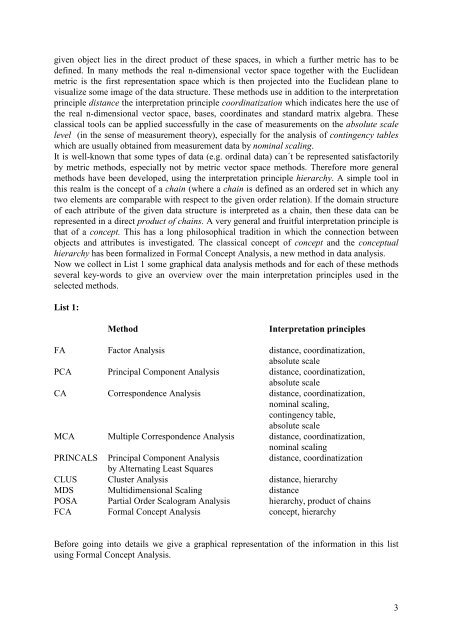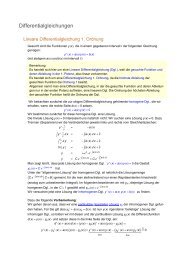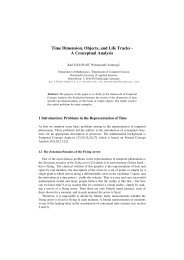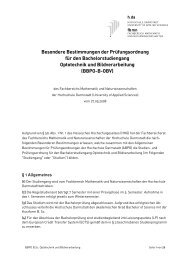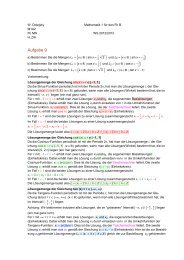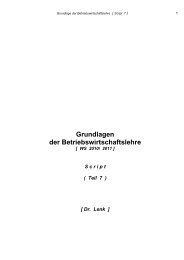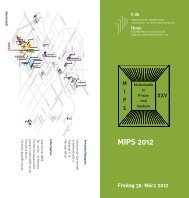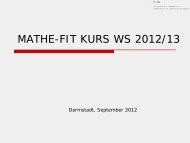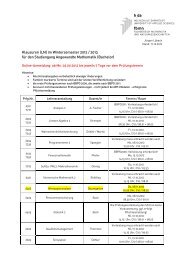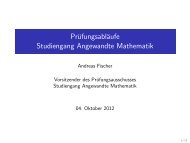comparison of graphical data analysis methods - Hochschule ...
comparison of graphical data analysis methods - Hochschule ...
comparison of graphical data analysis methods - Hochschule ...
You also want an ePaper? Increase the reach of your titles
YUMPU automatically turns print PDFs into web optimized ePapers that Google loves.
given object lies in the direct product <strong>of</strong> these spaces, in which a further metric has to be<br />
defined. In many <strong>methods</strong> the real n-dimensional vector space together with the Euclidean<br />
metric is the first representation space which is then projected into the Euclidean plane to<br />
visualize some image <strong>of</strong> the <strong>data</strong> structure. These <strong>methods</strong> use in addition to the interpretation<br />
principle distance the interpretation principle coordinatization which indicates here the use <strong>of</strong><br />
the real n-dimensional vector space, bases, coordinates and standard matrix algebra. These<br />
classical tools can be applied successfully in the case <strong>of</strong> measurements on the absolute scale<br />
level (in the sense <strong>of</strong> measurement theory), especially for the <strong>analysis</strong> <strong>of</strong> contingency tables<br />
which are usually obtained from measurement <strong>data</strong> by nominal scaling.<br />
It is well-known that some types <strong>of</strong> <strong>data</strong> (e.g. ordinal <strong>data</strong>) can´t be represented satisfactorily<br />
by metric <strong>methods</strong>, especially not by metric vector space <strong>methods</strong>. Therefore more general<br />
<strong>methods</strong> have been developed, using the interpretation principle hierarchy. A simple tool in<br />
this realm is the concept <strong>of</strong> a chain (where a chain is defined as an ordered set in which any<br />
two elements are comparable with respect to the given order relation). If the domain structure<br />
<strong>of</strong> each attribute <strong>of</strong> the given <strong>data</strong> structure is interpreted as a chain, then these <strong>data</strong> can be<br />
represented in a direct product <strong>of</strong> chains. A very general and fruitful interpretation principle is<br />
that <strong>of</strong> a concept. This has a long philosophical tradition in which the connection between<br />
objects and attributes is investigated. The classical concept <strong>of</strong> concept and the conceptual<br />
hierarchy has been formalized in Formal Concept Analysis, a new method in <strong>data</strong> <strong>analysis</strong>.<br />
Now we collect in List 1 some <strong>graphical</strong> <strong>data</strong> <strong>analysis</strong> <strong>methods</strong> and for each <strong>of</strong> these <strong>methods</strong><br />
several key-words to give an overview over the main interpretation principles used in the<br />
selected <strong>methods</strong>.<br />
List 1:<br />
Method<br />
Interpretation principles<br />
FA Factor Analysis distance, coordinatization,<br />
absolute scale<br />
PCA Principal Component Analysis distance, coordinatization,<br />
absolute scale<br />
CA Correspondence Analysis distance, coordinatization,<br />
nominal scaling,<br />
contingency table,<br />
absolute scale<br />
MCA Multiple Correspondence Analysis distance, coordinatization,<br />
nominal scaling<br />
PRINCALS Principal Component Analysis distance, coordinatization<br />
by Alternating Least Squares<br />
CLUS Cluster Analysis distance, hierarchy<br />
MDS Multidimensional Scaling distance<br />
POSA Partial Order Scalogram Analysis hierarchy, product <strong>of</strong> chains<br />
FCA Formal Concept Analysis concept, hierarchy<br />
Before going into details we give a <strong>graphical</strong> representation <strong>of</strong> the information in this list<br />
using Formal Concept Analysis.<br />
3


